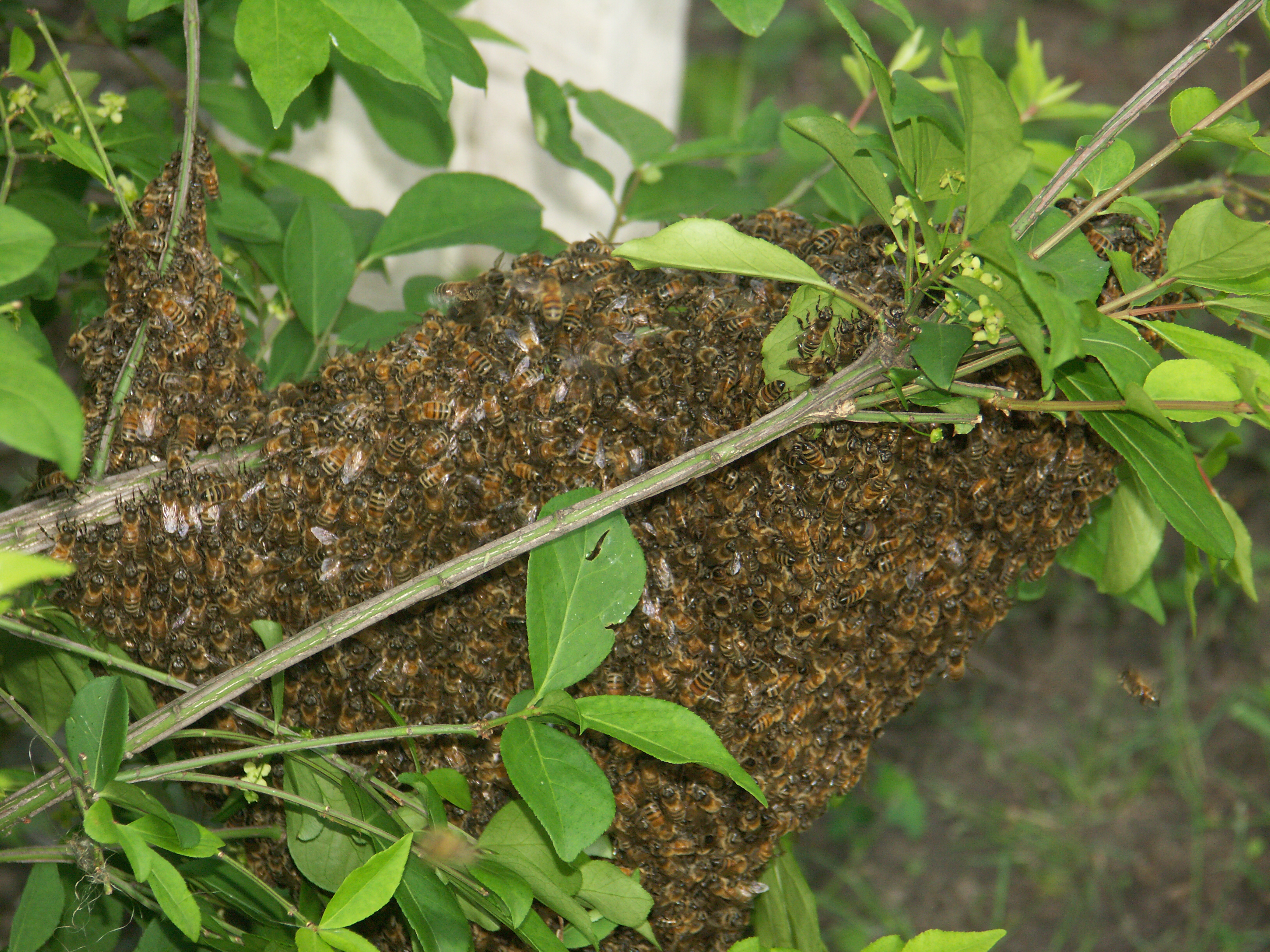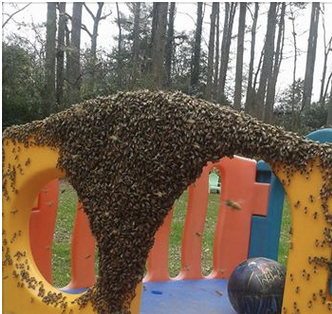Picture of the Week
April 4, 2022
Seeing Swarms of Honey Bees is a Good Thing
Tim Gibb, Department of Entomology, Purdue University
Large swarms of honey bees that suddenly appear on homes, bushes or in yards sometimes send people into shock. This is because a swarm may contain several hundred to several thousand bees that people have come to fear as dangerous stinging insects. Swarming bees are actually non- threatening and the swarming behavior is a natural means for bees to reproduce.
Swarms can occur most anytime throughout the year but most often occur in late spring or early summer. They occur when a new queen is made in a colony. The new queen's mother leaves the original colony takes with her a large group of worker bees to find a new home.
These bees all fly off as a group and clusters on a tree limb, a shrub, or even on a car's side mirror, nearly any other suitable space. They will remain there for an hour to a few days. During that time, scouting bees search for a new nest site. When a suitable location for the new colony is found, such as a hollow tree, the cluster breaks up and flies to it.
People need not be frightened by bee swarms because the bees at this stage of their life cycle lack a hive to defend. Until they have a new hive, they are not very aggressive. This does not mean that bees will not sting if they are provoked, however. They are just much less likely to sting.
In most situations, witnessing a swarm of honey bees offers a rare learning opportunity. Swarms are beautiful in their own right and should be appreciated (from a safe distance). They are a marvel of nature and offer an opportunity to teach people, young and old, about how bees communicate, their biology (possibly an opportunity to discuss the birds and the bees) as well as an opportunity to appreciate their value to the environment and the tremendous benefits that they provide people. Pollination is probably the most valuable of these benefits, followed by honey and wax production.
So, in most situations when a honey bee swarm is found on a tree, shrub or house, no action is required. Remember that swarms are almost always temporary and the bees will move on within hours, or at most a few days, if you patiently ignore them.
Having said that, there are a very few times and places where honey bees can create an annoyance or a nuisance, and for sting-sensitive individuals, a possible health threat.
Only if a serious health threat is present because of the location of the swarm, such as in a highly traveled public area, should you need to do anything with a bee swarm. An experienced beekeeper may be contacted and paid to come and gather the swarm and relocate it for you.
Examples of Swarming Bees
In the rare instance where a beekeeper cannot be found, pest management professionals can be contacted to remove the bees. They may kill the colony if they are not able to remove it safely. While it is not encouraged to kill a swarm of honey bees you may sometimes be left with little other option. If a swarm must be killed, spraying the swarm with soapy water (up to 1 cup of liquid dishwashing detergent in a gallon of water) or synthetic insecticide will suffice. Soapy water sprays are preferred because the bees are less agitated; aerosol wasp and hornet sprays are more likely to irritate the bees before they die, increasing the chances of someone being stung. In either case, spraying a honey bee swarm is a risky operation because of the large number of bees present. Waiting until after dark, when bees are less active, will help reduce chances of a sting.
Beneficial Flowers for HOney Bees
If honey bees nest in an attic or in the walls of a home, they should be removed or killed promptly and professionally. After several months, honey bees may have stored a considerable amount of honey, food reserves and brood. Should the bees die at this time, the wax and honey may melt and run causing a serious mess, usually in an inconvenient location. In addition, the decaying brood and honey and comb will likely attract undesirable rodents and insects. In these cases, you may have to seek the assistance of an exterminator to work closely with an experienced carpenter to kill the bees, open the wall, and remove the hive, and restore the structure.
You can prevent bees and other insects from nesting in walls or attics with preventive maintenance. Honey bees will not create an entrance to a nest. Rather, they look for an existing opening, so periodic inspection and sealing holes and cracks where bees can get in, is all that is necessary to prevent them from setting up residence in buildings.
Click the image below for other related articles on bees:
"Murder" Hornets: Should you panic? Carpenter bees









